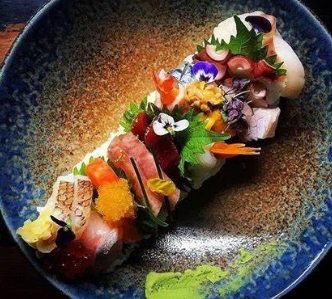Sushi is one of Japan’s most iconic dishes, known for its delicate flavors, beautiful presentation, and intricate preparation. A dish that has transcended borders, sushi has become a beloved culinary art form around the world, often symbolizing the elegance and sophistication of Japanese cuisine. Whether enjoyed in a high-end sushi restaurant or as a quick bite from a conveyor belt sushi bar, sushi continues to captivate diners with its fresh ingredients and meticulously crafted combinations.
The origins of sushi can be traced back to the 8th century when it was first developed as a way of preserving fish. In ancient times, fish was salted and fermented with rice to keep it from spoiling. Over time, this preservation technique evolved into a more refined form of sushi, with the rice itself becoming an integral part of the dish. By the Edo period (1603-1868), sushi as we know it today began to take shape, with nigiri sushi (hand-pressed sushi) becoming popular in Tokyo (then Edo).
Today, sushi is typically made with vinegar-seasoned rice and raw fish, although there are many variations that include cooked seafood, vegetables, and even fruits. The dish is revered for its simplicity, with the freshness of the ingredients being the star of the show. Whether it’s the delicate flavor of salmon, the sweet taste of shrimp, or the briny depth of seaweed, every element in sushi is carefully selected to create a harmonious balance.
One of the most popular forms of sushi is nigiri, a small mound of vinegared rice topped with a slice of fish or seafood. Classic nigiri includes varieties like tuna (maguro), salmon (sake), yellowtail (hamachi), and eel (unagi), each of which is carefully sliced and placed atop the rice. Nigiri is often served with a small dollop of wasabi (a sharp, spicy condiment) between the rice and fish, adding a bit of heat and enhancing the natural flavors.
Another well-known sushi style is maki, which consists of rice and fillings rolled in a sheet of nori (seaweed) and sliced into bite-sized pieces. Maki can be filled with a variety of ingredients, from tuna and salmon to cucumber and avocado, making it a versatile choice for sushi lovers. There are different types of maki rolls, including hosomaki (thin rolls), uramaki (inside-out rolls), and temaki (hand rolls), each offering a unique take on the sushi experience.
One of the more indulgent sushi varieties is sashimi, which consists of thin slices of raw fish served without rice. Sashimi is often served with a side of soy sauce, wasabi, and pickled ginger (which helps cleanse the palate between bites). Sashimi allows diners to fully appreciate the purity and freshness of the fish, as it is the star of the dish, without the accompaniment of rice.
While raw fish is the hallmark of sushi, there are also many cooked options. Tempura rolls, which feature crispy, battered seafood or vegetables, and unagi (grilled eel) are common cooked items in sushi dishes. Some sushi rolls may even include cream cheese, spicy mayo, or tobiko (fish roe) to add different textures and flavors. Vegetarian sushi, made with ingredients like avocado, cucumber, pickled radish, and tofu, offers a light and refreshing alternative for those who prefer non-seafood options.
The key to great sushi lies in the quality of the ingredients. Fish and seafood used in sushi must be fresh and of the highest quality, often sourced from local markets or trusted suppliers. The rice is also essential: it must be perfectly cooked and seasoned with rice vinegar, sugar, and salt to give it just the right balance of flavor. Wasabi, a pungent green paste made from horseradish, is also a crucial ingredient that adds heat and flavor to the sushi experience.
Sushi chefs undergo years of rigorous training to perfect the art of sushi-making. The process is as much about technique as it is about passion, with each movement and gesture carefully honed to create the perfect sushi. In high-end sushi restaurants, chefs may even prepare the sushi right in front of diners, allowing them to experience the artistry of the craft firsthand. The precision and attention to detail involved in sushi preparation are what elevate it to a truly remarkable dining experience.
Sushi is often enjoyed with soy sauce, which is used for dipping, though it is important not to over-dip the sushi as it can overpower the delicate flavors. Pickled ginger is traditionally eaten between different types of sushi to cleanse the palate, while wasabi adds a spicy kick to each bite. These condiments, when used properly, complement the sushi and enhance its overall enjoyment.
In Japan, sushi is not just a meal—it’s a ritual and an important part of social gatherings. Whether it’s at a casual sushi bar, a celebratory event, or a formal sushi dinner, the experience of sharing sushi with others is a cherished tradition. Sushi is often enjoyed with sake (Japanese rice wine) or green tea, both of which pair beautifully with the dish’s flavors.
Sushi is not just a dish; it’s an art form that reflects the Japanese reverence for fresh ingredients, meticulous preparation, and a deep connection to the seasons. Sushi chefs take great pride in creating dishes that honor these principles, ensuring that each piece of sushi is a work of culinary craftsmanship.
With its growing popularity around the world, sushi has evolved into a global phenomenon, with sushi restaurants and sushi bars popping up in cities across the globe. As sushi continues to evolve, there are more innovative variations being created, such as sushi burritos, sushi bowls, and even sushi pizzas, all of which reflect the creativity of chefs worldwide while staying true to the roots of this Japanese culinary tradition.
In conclusion, sushi is much more than just a meal—it’s a cultural experience that embodies the artistry, precision, and elegance of Japanese cuisine. Whether you’re enjoying it in Tokyo, New York, or anywhere in between, sushi remains a timeless dish that continues to inspire and delight food lovers everywhere.





